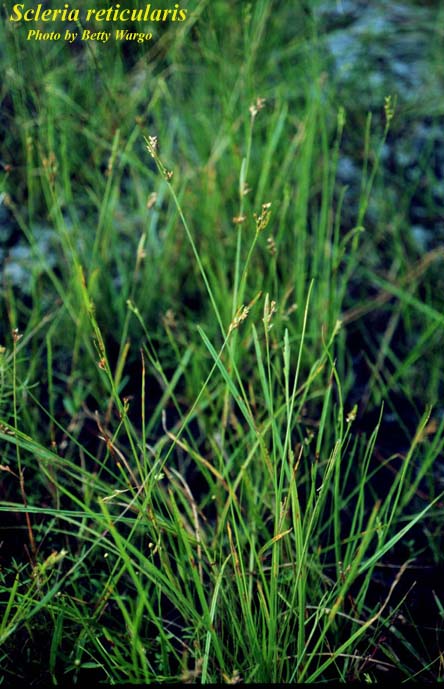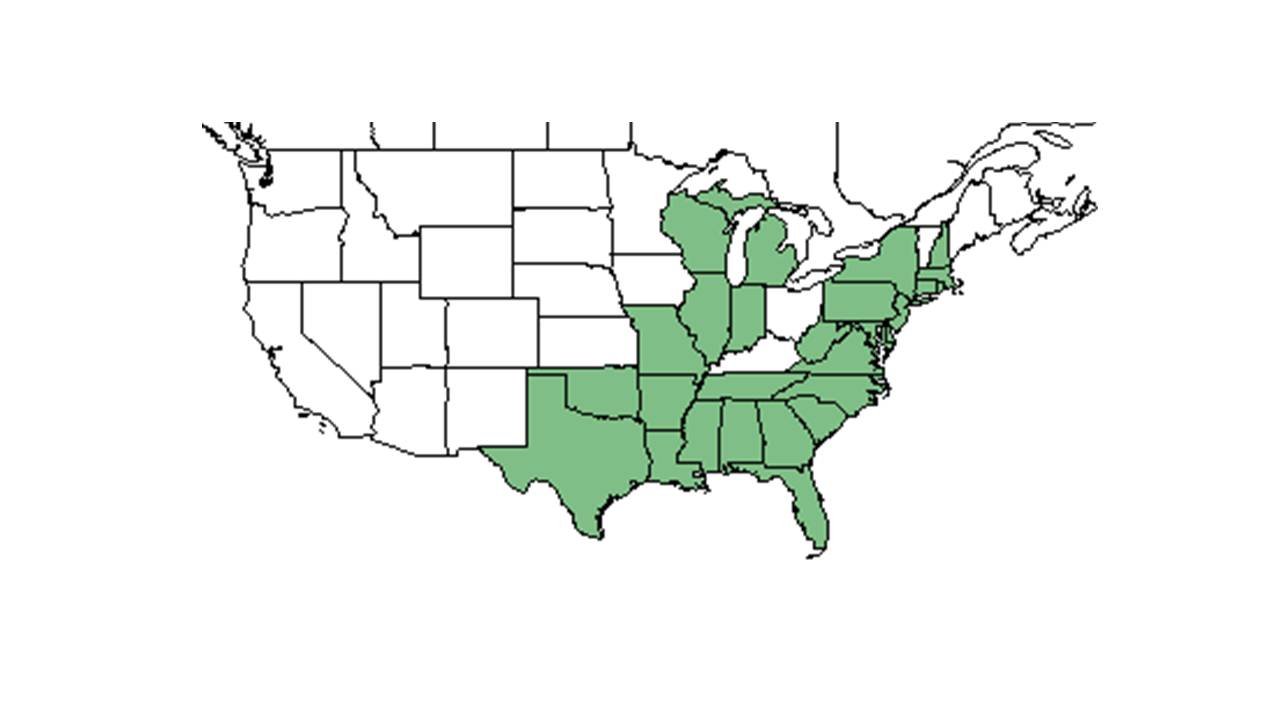Scleria reticularis
| Scleria reticularis | |
|---|---|

| |
| Photo by Betty Wargo, Atlas of Florida Vascular Plants | |
| Scientific classification | |
| Kingdom: | Plantae |
| Division: | Magnoliophyta – Flowering plants |
| Class: | Liliopsida – Monocotyledons |
| Order: | Cyperales |
| Family: | Cyperaceae |
| Genus: | Scleria |
| Species: | S. reticularis |
| Binomial name | |
| Scleria reticularis Michx. | |

| |
| Natural range of Scleria reticularis from USDA NRCS Plants Database. | |
Common name: Netted nutrush
Contents
Taxonomic notes
Synonym: None
Varieties: None.
Description
A description of Scleria reticularis is provided in The Flora of North America.
Distribution
Scleria reticularis is widespread across the southeastern Coastal Plain, and there are disjunct populations in the Great Lakes Region.[1]
Ecology
Habitat
In the Coastal Plain in Florida, S. reticularis can be found in wet, mesic and dry savannas, pine-wiregrass savannas, depression marshes, mesic mixed hardwoods, shores of natural ponds, seepage bogs, wet pine thickets, lake shores, dried up ponds, interdune ponds, swamps, and pine flatwoods.[2][3] It can also be found in unnatural ponds, roadside ditches, powerline corridors, clobbered wet flatwoods, hiking trails, sandy fields, borrowpits, choppped up savannas, swampy woodland clearings, and logged flatwoods. The historical range includes Alabama, Florida, Georgia, South Carolina, North Carolina, Massachusetts, New York and Missouri and is considered rare species associated with depression wetlands in the southeastern Coastal Plain.[4]
Associated species include Eleocharis equisetoides, Nymphaea, Rhynchospora, Panicum, Juncus, Xyris, Sagittaria isoetiformis, Lachnocaulon, Pinguicula, bahiagrass, bermudagrass, Rhynchospora oligantha, Cuphea aspera, Verbesina chapmanii, Magnolia, Nyssa, Pinckneya, Liquidambar, Quercus, Scleria verticillata, Anthaenantia, Pleea, Drosera, Macbridea alba, Phyla and Cyperus.[2]
Soils include sandy peat and loamy sand.[2]
Phenology
This species is considered to be a short lived plant.[5] It has been observed to flower from August to September[6], and fruits June through November.[2]
Seed bank and germination
It is present in the seed bank in depression wetlands of the southeastern coastal plains from Virginia to the Florida panhandle.[4] S. reticularis was also found in the seed bank and fields of depression-meadow Carolina bays in south central South Carolina.[7]
An early 2000s study found that while D. breviolia is found in the seed beds of pine flatwoods soils, it is absent from the seed banks in soils of old agricultural fields.[8]
Fire ecology
S. reticularis was one of the several species to increase in frequency from significant change (from pre-fire to post-fire).[5] “S. reticularis produced greater numbers of flowering stalks in second post-fire census than in the pre-fire census.”[5] Populations of Scleria reticularis have been known to persist through repeated annual burns.[9]
Conservation, cultivation, and restoration
Cultural use
Photo Gallery
References and notes
- ↑ Sorrie, B. A. and A. S. Weakley 2001. Coastal Plain valcular plant endemics: Phytogeographic patterns. Castanea 66: 50-82.
- ↑ 2.0 2.1 2.2 2.3 Florida State University Robert K. Godfrey Herbarium database. URL: http://herbarium.bio.fsu.edu. Last accessed: July 2015. Collectors: Loran C. Anderson, Steve Mortellaro, C. Jackson, Robert Kral, __Kral, R.K. Godfrey, Gary R. Knight, William P. Adams, S. M. Tracy, Robert J Lemaire, Richard D. Houk, Grady W. Reinert, John B. Nelson, R. F. Thorne, R. A. Davidson, R. F. Doren, Cecil R Slaughter, Dianne Hall, A. Clewell. States and Counties: Florida: Alachua, Bay, Brevard, Broward, Calhoun, Clay, Duval, Franklin, Gadsden, Gilchrist, Gulf, Hernando, Jackson, Jefferson, Leon, Levy, Liberty, Manatee, Marion, Okaloosa, Orange, Osceola, Palm Beach, Putnam, Sarasota, Seminole, St. Lucie, Taylor, Wakulla, Walton, Washington. Country: Honduras. Compiled by Tall Timbers Research Station and Land Conservancy.
- ↑ Walker, J. and R. K. Peet. 1983. Composition and species diversity of pine-wiregrass savannas of the Green Swamp, North Carolina. Vegetatio 55:163-179.
- ↑ 4.0 4.1 Edwards, A. L. and A. S. Weakley. 2001. Population biology and management of rare plants in depression wetlands of the southeastern coastal plain, USA. Natural Areas Journal 21:12-35.
- ↑ 5.0 5.1 5.2 Hinmann, S. E. and J. S. Brewer. 2007. Responses of two frequently-burned wet pine savannas to an extended period without fire. Journal of the Torrey Botanical Society 134:512-526.
- ↑ Nelson, G. PanFlora: Plant data for the eastern United States with emphasis on the Southeastern Coastal Plains, Florida, and the Florida Panhandle. www.gilnelson.com/PanFlora/ Accessed: 19 MAY 2021
- ↑ Kirkman, L. K. and R. R. Sharitz 1994. Vegetation disturbance and maintenance of diversity in intermittently flooded Carolina bays in South Carolina. Ecological Applications 4 (1):177-188.
- ↑ Jenkins, Amy Miller. Seed banking and vesicular-arbuscular mycorrhizae in pasture restoration in central Florida. University of Florida. 2003.
- ↑ Robertson, K.M. Unpublished data collected from Pebble Hill Fire Plots, Pebble Hill Plantation, Thomasville, Georgia.